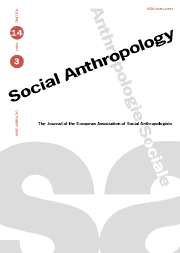Article contents
Dissimulation and simulation as forms of religious reflexivity
Published online by Cambridge University Press: 06 March 2002
Abstract
This paper discusses conventional illusory enactments, largely recognised as such by those who undertake them, drawn from two Central African male initiation rites: the novices' dramatic execution on the one hand, and the purportedly painless sacrifice of the ritual's emblematic animal on the other. In doing so, it attempts to elucidate two related forms of religious reflexivity: ritual ‘dissimulation’, centred around the manipulation of persons, and ritual ‘simulation’ founded upon the manipulation of non-persons (animals, objects, spells, images, and so forth). The actors' commitment to such performances as necessary and appropriate ones is related in the first case to the interdependent relationship that is set up between the perceptions different categories of participants have of the event they are jointly involved in, and in the second case, to the way the mediating qualities of non-persons serve to embed the participants' actions within auto-referential circuits in which relations of causality and representation converge.
- Type
- Research Article
- Information
- Copyright
- © 2002 European Association of Social Anthropologists
- 1
- Cited by


